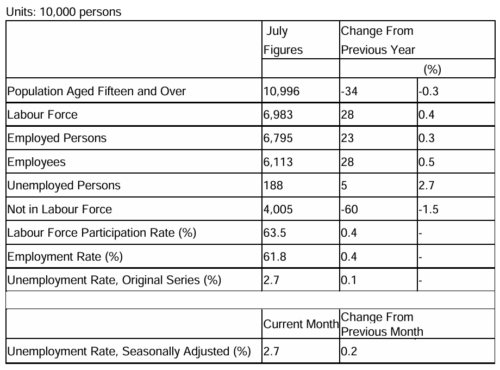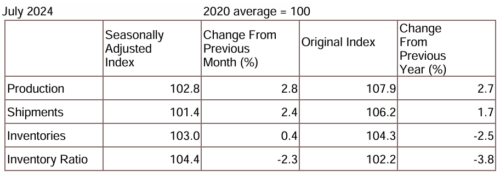Economic and Labour Situation in Japan, September 2024
Real Wages in June Turn Positive for the First Time in 27 Months
The total amount of cash earnings, including base salary and bonuses per worker in July this year, increased by 4.5% compared to the same month of the previous year, marking the highest growth rate in approximately 27 years. As a result, real wages, which reflect price changes, also turned positive for the first time in 27 months.
The Ministry of Health, Labour, and Welfare conducts a “Monthly Labour Survey” targeting over 30,000 business establishments with five or more employees nationwide and has published the finalized figures for July this year.
According to the survey, total cash earnings, including base salary, overtime pay, and bonuses, averaged 498,887 yen per person, an increase of 4.5% compared to the same month of the previous year, representing the highest growth rate since 1997, about 27 years ago.
Among these, scheduled earnings, such as base salary, increased by 2.2% to 264,483 yen, while specially paid earnings, such as bonuses, increased by 7.8% to 215,007 yen.
As a result, real wages, which reflect price fluctuations, increased by 1.1% compared to the same month of the previous year, turning positive for the first time in 27 months.
Looking at cash earnings by employment type, full-time workers, mainly regular employees, saw a 5.0% increase to 665,313 yen, while part-time workers saw a 5.7% increase to 121,664 yen. The base salary for full-time workers increased by 2.7%, marking the highest growth rate since comparable data became available in 1994.
The Ministry of Health, Labour, and Welfare stated, “The increase in scheduled earnings is attributed to the effects of this year’s spring wage negotiations, along with an above-average increase in the number of businesses that paid bonuses in July. Although inflation is expected to continue, we will closely monitor whether the positive trend in real wages can be maintained.”
Labour Force Survey Monthly Results*1
(1) Employment
The number of employed persons in July 2024 was 67.95 million, an increase of 230,000 over the same month the previous year. By gender, this included 37.22 million men, up 90,000, and 30.74 million women, up 150,000 over the previous year.
(2) Unemployment
The number of unemployed persons in July 2024 was 1.88 million, an increase of 50,000 from the same month in the previous year.
The seasonally adjusted unemployment rate in July was 2.7%, up 0.2 points over the previous month, which had been the first deterioration in five months, as more workers left their jobs in search of improved working conditions. The unemployment rate for men was 2.7%, up 0.1 points over the previous month, and for women 2.6%, up 0.2 points over the previous month.

(3) Job Availability
Japan’s job availability in July stood at 1.24, up 0.01 points over the previous month. This ratio means there were 124 job openings for every 100 job seekers.
The ratio of regular employee job offers to applicants was 1.00, unchanged from the previous month.
The ratio of new job offers to applicants, a leading indicator for the labour market, was 2.22, down 0.04 points from the previous month. The number of new job offers increased 1.2%. By industry, scientific research, professional and technical services increased 7.4% and transport and postal activities increased 6.6%. Manufacturing dropped 2.9%.
Industrial Production*2
Industrial output in July increased 2.8% over the previous month, as production of semiconductor equipment and electrical devices was boosted by overseas and data center demand.
Production, shipment, and inventories all increased, while inventory ratio decreased. The industries that mainly contributed to this increase were as follows: (1) electrical machinery, and information and communication electronics equipment; (2) production machinery; (3) electronic parts and devices, in that order.
According to the Survey of Production Forecasts in Manufacturing, production was expected to increase 2.2% in August and decrease 3.3% in September.

Family Income and Expenditure Survey *3
(1) Expenditure of Households of Two Persons or More
Average monthly consumption expenditure of households of two or more persons in July was 290,931 yen, up 3.3% in nominal terms and up 0.1% in real terms over the previous year, which was the first improvement in three months.
(2) Income and Expenditures for Workers’ Households
Average monthly income per household stood at 694,483 yen (including bonus payments), up 8.9% in nominal terms and up 5.5% in real terms from the previous year. The average level of consumption expenditure was 312,568 yen per month, up 2.0% in nominal terms but down 1.2% in real terms year-on-year.
Consumer Prices *4
The consumer price index (CPI) in July was 108.6 (2020 = 100), up 2.8% over the previous year and up 0.2% over the previous month. Core inflation (CPI less food and energy) was up 1.9% over the previous year and up 0.1% over the previous month, reflecting higher energy costs and elevated food prices.
Energy prices increased 12.0%, with electricity jumping 22.3%, the biggest rise since 1981 when the oil shock jacked up fuel prices. The government recently decided to resume subsidies temporarily from September. Prices of rice, Japan’s staple food, were up 18.0%, the biggest increase in 20 years, due to lower supply following a hot summer last year.

<Y.A>
- Source: Labour Force Survey Monthly Results (Statistics Bureau of Japan)
https://www.stat.go.jp/english/data/roudou/results/month/index.html - Source: Indices of Industrial Production (Ministry of Economy, Trade and Industry)
https://www.meti.go.jp/english/statistics/tyo/iip/index.html - Source: Summary of the Latest Month on Family Income and Expenditure Survey (Statistics Bureau of Japan)
https://www.stat.go.jp/english/data/kakei/156.html - Source: Consumer Price Index (Statistics Bureau of Japan)
https://www.stat.go.jp/english/data/cpi/1581-z.html
